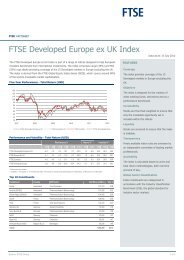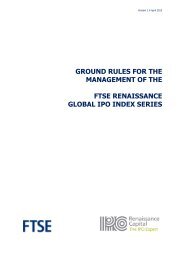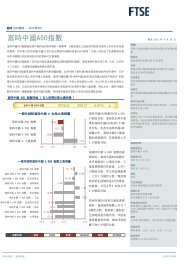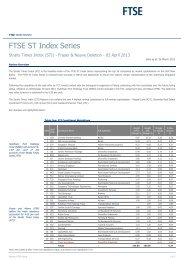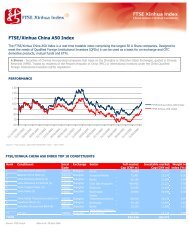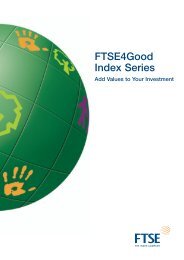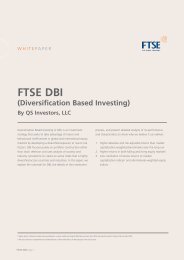FTSE JSE Africa Index Series Ground Rules v3.0x
FTSE JSE Africa Index Series Ground Rules v3.0x
FTSE JSE Africa Index Series Ground Rules v3.0x
You also want an ePaper? Increase the reach of your titles
YUMPU automatically turns print PDFs into web optimized ePapers that Google loves.
Growth Measures<br />
• 3 Year Historic Earnings Per Share Growth<br />
3 Year Historic EPS Growth is the average of the company’s three most recent<br />
consecutive absolute EPS annual growth values. The most recent EPS value should be<br />
less than 18 months old (in developed markets). Annual earnings per share (EPS) is for<br />
the 12 months to fiscal year end. EPS is calculated as net income after taxes, minority<br />
interest and preferred dividends, but before amortization of intangibles and after-tax<br />
extraordinary items, divided by adjusted shares.<br />
• 3 Year Historic Sales Growth<br />
3 Year Historic Sales Growth reflects the average of the company’s three most recent<br />
consecutive absolute net sales or revenue annual growth values. The most recently<br />
reported sales value should be less than 18 months old (in developed markets). Sales<br />
values are for the 12 months to the company's fiscal year end and are generally as<br />
reported by the company. However, sales are generally adjusted to exclude excise taxes,<br />
sales from non-operating activities and discontinued operations in addition to sales<br />
generated by associated companies. If the company has changed its year end and a 12<br />
month figure is not reported, the reported value is annualised. A sales value is also<br />
calculated for banks, insurance & financial companies and includes interest, investment &<br />
premium income in addition to commission & fees as appropriate.<br />
• 2 Year Forward Earnings Per Share Growth<br />
EPS estimates are generally based on net income from continuing operations divided by<br />
weighted average shares outstanding for the year.<br />
• 2 Year Forward Sales Growth<br />
Sales estimates generally reflect sales derived from the company's core-operating<br />
activities. Generally transportation & non-operating costs are excluded from gross<br />
revenues for industrial corporations. Bank revenues include interest and non-interest<br />
income. Insurance revenues are comprised of net technical income and net financial<br />
income.<br />
• Return On Equity*(1 - Payout Ratio)<br />
Return on Equity is Earnings per Share (EPS) for the most recent fiscal year divided by<br />
the previous year’s book value per share. Payout ratio is Dividend per Share (DPS)<br />
divided by EPS. Values are again for the 12 months to the most recent fiscal year end.<br />
(More detailed EPS, Book Value and dividend per share definitions can be found under<br />
the "3 Year historic EPS growth", "Book to Price", "Dividend Yield" headings respectively).<br />
12.5.3 The style items are subsequently normalised:<br />
• The data on each x–axis is truncated (see below). Outliers beyond the truncation limits<br />
remain outside of the truncation limit itself. No data item is discarded.<br />
• The truncation levels for each fundamental data item are as follows:-<br />
Value Measures Lower Level Upper Level<br />
Book to Price -20 20<br />
Sales to Price -30 30<br />
Dividend Yield 0 20<br />
Cash Flow to Price -200 200<br />
Growth Measures Lower Level Upper Level<br />
3 Year Historic Earnings Per Share Growth -200 200<br />
3 Year Historic Sales Growth -70 70<br />
2 Year Forward Earnings Per Share Growth -200 200<br />
2 Year Forward Sales Growth -70 70<br />
Return On Equity* (1 - Payout Ratio) -300 300<br />
<strong>Ground</strong> <strong>Rules</strong> for the Management of the <strong>FTSE</strong>/<strong>JSE</strong> <strong>Africa</strong> <strong>Index</strong> <strong>Series</strong> 31<br />
Version 3.1 July 2013



